Spatial-Temporal Footprints Assessment and Driving Mechanism of China Household Diet Based on CHNS
Abstract
:1. Introduction
2. Materials and Methods
2.1. Research Area
2.2. Food Classification
2.3. Methods
- (1)
- Dietary WF:
- (2)
- Dietary CF:
- (3)
- Dietary NF:
- (4)
- Dietary EF:
- (5)
- Dietary LF:
2.4. Driver Factor Screening and Analysis
2.5. Data Sources and Processing
3. Results
3.1. Spatial-Temporal Analysis for Multiple Footprints of Food Consumption
3.2. Spatial-Temporal Analysis for Multiple Footprints Intensity of Energy Intake
3.3. Spatial-Temporal Analysis for Multiple Footprints Intensity of Protein Intake
3.4. Spatial-Temporal Analysis for Multiple Footprints Intensity of Insoluble Dietary Fiber Intake
3.5. Spatial-Temporal Analysis for Multiple Footprints Intensity of Cholesterol Intake
3.6. Driving Factors of Multiple Footprints of Food Consumption
3.7. Scenario Analysis of Different Dietary Patterns
4. Discussion
4.1. Driving Mechanism of Household Dietary Footprints
4.2. Suggestions for Sustainable Dietary Adjustment
5. Conclusions
- (1)
- During 2000–2011 in China, household dietary consumption WF, CF, NF and EF were decreased by 18.24%, 17.82%, 12.03% and 20.36%, respectively. However, the LF remained stable within the time scale of the research. For footprint intensity, the , (−9.74%) and (−11.31%) have decreased, while , and have increased by 10.23% and 7.34%, respectively.
- (2)
- Nutritional intake ratio, household attributes, educational and health consciousness had a stronger correlation with dietary footprints. Among these, protein intake had a stronger positive correlation with WF, and , while the proportion of carbohydrate intake had a stronger negative correlation with WF, , and . The proportion of fat intake had a stronger positive correlation with . The proportion of carbohydrate intake had a stronger positive correlation with , and the proportion of protein intake that had a stronger negative correlation was .
- (3)
- The multiple footprints of Chinese household food consumption are much higher than the dietary pattern recommended in the Chinese Dietary Guidelines 2016. It is strongly suggested that the households reduce animal-derived foods with high footprints (especially beef and mutton). Additionally, household should increase the intake of fruits and vegetables to reduce the size of the multiple footprints.
Supplementary Materials
Author Contributions
Funding
Data Availability Statement
Acknowledgments
Conflicts of Interest
References
- Yuan, M.-H.; Lo, S.-L. Ecosystem services and sustainable development: Perspectives from the food-energy-water Nexus. Ecosyst. Serv. 2020, 46, 101217. [Google Scholar] [CrossRef]
- Kearney, J. Food consumption trends and drivers. Philos. Trans. R. Soc. B Biol. Sci. 2010, 365, 2793–2807. [Google Scholar] [CrossRef] [PubMed]
- Godfray, H.C.J.; Beddington, J.R.; Crute, I.R.; Haddad, L.; Lawrence, D.; Muir, J.F.; Pretty, J.; Robinson, S.; Thomas, S.M.; Toulmin, C.J.S. Food security: The challenge of feeding 9 billion people. Science 2010, 327, 812–818. [Google Scholar] [CrossRef] [PubMed] [Green Version]
- He, G.H.; Zhao, Y.; Wang, L.Z.; Jiang, S.; Zhu, Y.N. China’s food security challenge: Effects of food habit changes on requirements for arable land and water. J. Clean Prod. 2019, 229, 739–750. [Google Scholar] [CrossRef]
- Jiang, L.; Guo, S.; Wang, G.; Kan, S.; Jiang, H. Changes in agricultural land requirements for food provision in China 2003–2011: A comparison between urban and rural residents. Sci. Total. Environ. 2020, 725, 138293. [Google Scholar] [CrossRef] [PubMed]
- El-Gafy, I. Water-food-energy nexus index: Analysis of water-energy-food nexus of crop’s production system applying the indicators approach. Appl. Water Sci. 2017, 7, 2857–2868. [Google Scholar] [CrossRef] [Green Version]
- Yue, Q.; Guo, P. Managing agricultural water-energy-food-environment nexus considering water footprint and carbon footprint under uncertainty. Agric. Water Manag. 2021, 252, 106899. [Google Scholar] [CrossRef]
- Tilman, D.; Fargione, J.; Wolff, B.; D’Antonio, C.; Dobson, A.; Howarth, R.; Schindler, D.; Schlesinger, W.H.; Simberloff, D.; Swackhamer, D. Forecasting agriculturally driven global environmental change. Science 2001, 292, 281–284. [Google Scholar] [CrossRef] [PubMed] [Green Version]
- de Amorim, W.S.; Valduga, I.B.; Ribeiro, J.M.P.; Williamson, V.G.; Krauser, G.E.; Magtoto, M.K.; de Andrade Guerra, J.B.S.O. The nexus between water, energy, and food in the context of the global risks: An analysis of the interactions between food, water, and energy security. Environ. Impact Assess. Rev. 2018, 72, 1–11. [Google Scholar] [CrossRef]
- Xie, Y.; Li, X.; Hu, X.; Hu, X. The landscape of academic articles in environmental footprint family research: A bibliometric analysis during 1996–2018. Ecol. Indic. 2020, 118, 106733. [Google Scholar] [CrossRef]
- Hoekstra, A.Y.; Chapagain, A.K. Water footprints of nations: Water use by people as a function of their consumption pattern. Water Resour. Manag. 2006, 21, 35–48. [Google Scholar] [CrossRef]
- Wiedmann, T.; Minx, J. A definition of ‘carbon footprint’. Ecol. Econ. Res. Trends 2008, 1, 1–11. [Google Scholar]
- Rees, W.E. Ecological Footprints and Appropriated Carrying Capacity: Measuring the Natural Capital Requirements of the Human Economy. Focus 1996, 6, 121–130. [Google Scholar]
- Ferng, J.J. Toward a scenario analysis framework for energy footprints. Ecol. Econ. 2002, 40, 53–69. [Google Scholar] [CrossRef]
- Castellani, B.; Rinaldi, S.; Bonamente, E.; Nicolini, A.; Rossi, F.; Cotana, F. Carbon and energy footprint of the hydrate-based biogas upgrading process integrated with CO2 valorization. Sci. Total. Environ. 2018, 615, 404–411. [Google Scholar] [CrossRef] [PubMed]
- Ibidhi, R.; Hoekstra, A.Y.; Gerbens-Leenes, P.W.; Chouchane, H. Water, land and carbon footprints of sheep and chicken meat produced in Tunisia under different farming systems. Ecol. Indic. 2017, 77, 304–313. [Google Scholar] [CrossRef]
- Ruiter, H.d.; Macdiarmid, J.I.; Matthews, R.B.; Kastner, T.; Lynd, L.R.; Smith, P. Total global agricultural land footprint associated with UK food supply 1986–2011%. J. Glob. Environ. Chang. 2017, 43, 72–81. [Google Scholar] [CrossRef]
- Masud, M.B.; McAllister, T.; Cordeiro, M.R.C.; Faramarzi, M. Modeling future water footprint of barley production in Alberta, Canada: Implications for water use and yields to 2064. Sci. Total. Environ. 2018, 616, 208–222. [Google Scholar] [CrossRef] [PubMed]
- Zhai, Y.J.; Zhang, T.Z.; Bai, Y.Y.; Ji, C.X.; Ma, X.T.; Shen, X.X.; Hong, J.L. Energy and water footprints of cereal production in China. Resour. Conserv. Recycl. 2021, 164, 10. [Google Scholar] [CrossRef]
- Li, N. Study on Energy Consumption and GHG Emissions of Agriculture in China. Ph.D. Thesis, Dalian University of Technology, Dalian, China, 2014. (In Chinese). [Google Scholar]
- Liu, J.; Savenije, H.H.G. Food consumption patterns and their effect on water requirement in China. Hydrol. Earth Syst. Sci. 2008, 12, 887–898. [Google Scholar] [CrossRef] [Green Version]
- Jin, E.; Al Fahel, N.; Mondal, P.; Li, H.; Archer, C.L. Energy footprint of food: The case of corn production in Delaware. Food Energy Secur. 2020, 9, 14. [Google Scholar] [CrossRef]
- Naja, F.; Jomaa, L.; Itani, L.; Zidek, J.; El Labban, S.; Sibai, A.M.; Hwalla, N. Environmental footprints of food consumption and dietary patterns among Lebanese adults: A cross-sectional study. Nutr. J. 2018, 17, 11. [Google Scholar] [CrossRef] [PubMed]
- Abbade, E.B. Land and water footprints associated with rice and maize losses in Brazil. Land Use Pol. 2020, 99, 9. [Google Scholar] [CrossRef]
- Xue, X.B.; Landis, A.E. Eutrophication Potential of Food Consumption Patterns. Environ. Sci. Technol. 2010, 44, 6450–6456. [Google Scholar] [CrossRef] [PubMed]
- Kashyap, D.; Agarwal, T. Carbon footprint and water footprint of rice and wheat production in Punjab, India. Agric. Syst. 2021, 186, 9. [Google Scholar] [CrossRef]
- Oita, A.; Wirasenjaya, F.; Liu, J.R.; Webeck, E.; Matsubae, K. Trends in the food nitrogen and phosphorus footprints for Asia’s giants: China, India, and Japan. Resour. Conserv. Recycl. 2020, 157, 9. [Google Scholar] [CrossRef]
- Wang, L.; Cui, S.H.; Hu, Y.C.; Connor, O.; Gao, B.; Huang, W.; Zhang, Y.; Xu, S. The co-benefits for food carbon footprint and overweight and obesity from dietary adjustments in China. J. Clean Prod. 2021, 289, 12. [Google Scholar] [CrossRef]
- Vanham, D.; Mekonnen, M.M.; Hoekstra, A.Y. The water footprint of the EU for different diets. Ecol. Indic. 2013, 32, 1–8. [Google Scholar] [CrossRef]
- Esteve-Llorens, X.; Darriba, C.; Moreira, M.T.; Feijoo, G.; Gonzalez-Garcia, S. Towards an environmentally sustainable and healthy Atlantic dietary pattern: Life cycle carbon footprint and nutritional quality. Sci. Total. Environ. 2019, 646, 704–715. [Google Scholar] [CrossRef]
- Blas, A.; Garrido, A.; Unver, O.; Willaarts, B. A comparison of the Mediterranean diet and current food consumption patterns in Spain from a nutritional and water perspective. Sci. Total. Environ. 2019, 664, 1020–1029. [Google Scholar] [CrossRef]
- Kovacs, B.; Miller, L.; Heller, M.C.; Rose, D. The carbon footprint of dietary guidelines around the world: A seven country modeling study. Nutr. J. 2021, 20, 10. [Google Scholar] [CrossRef] [PubMed]
- Jiang, X. Study on Water Footprint of Regional Electricity in Chia based on Life Cycle Assessment. Master’s Thesis, Shanghai Jiao Tong University, Shanghai, China, 2019. (In Chinese). [Google Scholar]
- Qin, L.; Hou, X.; Mei, T.; Duan, P. Spatial-Temporal Distribution Characteristics of Dietary Water Footprint for Urban and Rural Residents in China. Ecol. Econ. 2015, 31, 19–22. (In Chinese) [Google Scholar]
- Chaofan, X.; Zhiyun, O. Calculation and dynamic analysis of the food nitrogen footprints of urban and rural residents in Beijing. ACTA Ecol. Sin. 2016, 36, 2413–2421. [Google Scholar]
- Guo, M. Impact of Diet Changes on Nitrogen Flows in the Food Chain and Optimization Strategies in China. Ph.D. Thesis, China Agricultural University, Beijing, China, 2018. (In Chinese). [Google Scholar]
- China Health and Nutrition Survey. Available online: https://www.cpc.unc.edu/projects/china (accessed on 6 April 2018).
- National Development and Reform Commission of People’s Republic of China. Compilation of Cost-Benefit Data of National Agricultural Products; National Development and Reform Commission of People’s Republic of China: Beijing, China, 2002. (In Chinese) [Google Scholar]
- Yuexin, Y. Chinese Food Composition Table; Peking University Medical Press: Beijing, China, 2018. (In Chinese) [Google Scholar]
- Yuexin, Y. Chinese Food Composition Table; Peking University Medical Press: Beijing, China, 2019. (In Chinese) [Google Scholar]
- Timeline: The Evolution of American Eating Habits. Available online: https://www.nrn.com/food-trends/timeline-evolution-american-eating-habits (accessed on 18 September 2015).
- Lei, Y. Cultural Differences between China and Japan from the Perspective of Eating Habits. World Aff. 2018, 69–71. (In Chinese) [Google Scholar]
- Chinese Nutrition Society. Available online: http://en.cnsoc.org/ (accessed on 4 June 2021).
- Australian Dietary Guidelines. Available online: https://www.eatforhealth.gov.au/ (accessed on 27 July 2015).
- Oberritter, H.; Schaebethal, K.; von Ruesten, A.; Boeing, H. Der DGE-Ernahrungskreis—Darstellung und Basis der lebensmittelbezogenen Empfehlungen der DGE. Ernahrungs Umschau 2013, 60, 24–29. [Google Scholar]
- Bosire, C.K.; Lannerstad, M.; de Leeuw, J.; Krol, M.S.; Ogutu, J.O.; Ochungo, P.A.; Hoekstra, A.Y. Urban consumption of meat and milk and its green and blue water footprints—Patterns in the 1980s and 2000s for Nairobi, Kenya. Sci. Total. Environ. 2017, 579, 786–796. [Google Scholar] [CrossRef] [PubMed]
- Ju, L.; Yu, D.; Fang, H.; Guo, Q.; Xu, X.; Li, S.; Zhao, L. Trends and food sources composition of energy, protein and fat in Chinese residents, 1992–2012. J. Hyg. Res. 2018, 47, 689–694, 704. (In Chinese) [Google Scholar]
- Puigdueta, I.; Aguilera, E.; Cruz, J.L.; Iglesias, A.; Sanz-Cobena, A. Urban agriculture may change food consumption towards low carbon diets. Glob. Food Secur. 2021, 28, 100507. [Google Scholar] [CrossRef]
- Saget, S.; Costa, M.; Santos, C.S.; Vasconcelos, M.W.; Gibbons, J.; Styles, D.; Williams, M. Substitution of beef with pea protein reduces the environmental footprint of meat balls whilst supporting health and climate stabilisation goals. J. Clean. Prod. 2021, 297, 126447. [Google Scholar] [CrossRef]
- Craig, W.J.; Fresán, U. International Analysis of the Nutritional Content and a Review of Health Benefits of Non-Dairy Plant-Based Beverages. Nutrients 2021, 13, 842. [Google Scholar] [CrossRef]
- Poore, J.; Nemecek, T. Reducing food’s environmental impacts through producers and consumers. Science 2019, 363, 2. [Google Scholar] [CrossRef] [PubMed] [Green Version]
- Motswagole, B.; Jackson, J.; Kobue-Lekalake, R.; Maruapula, S.; Mongwaketse, T.; Kwape, L.; Thomas, T.; Swaminathan, S.; Kurpad, A.V.; Jackson, M. The Association of General and Central Obesity with Dietary Patterns and Socioeconomic Status in Adult Women in Botswana. J. Obes. 2020, 2020, 4959272. [Google Scholar] [CrossRef]
- Wang, Y. Research on the Impact of Education on Health Outcome under the Food Path. Ph.D. Thesis, China Agricultural University, Beijing, China, 2017. (In Chinese). [Google Scholar]
- Vajdi, M.; Nikniaz, L.; Asl, A.M.P.; Farhangi, M.A. Lifestyle patterns and their nutritional, socio-demographic and psychological determinants in a community-based study: A mixed approach of latent class and factor analyses. PLoS ONE 2020, 15, 16. [Google Scholar] [CrossRef] [PubMed]
- Song, G.; Semakula, H.M.; Fullana-i-Palmer, P. Chinese household food waste and its’ climatic burden driven by urbanization: A Bayesian Belief Network modelling for reduction possibilities in the context of global efforts. J. Clean. Prod. 2018, 202, 916–924. [Google Scholar] [CrossRef]
- Colozza, D.; Avendano, M. Urbanisation, dietary change and traditional food practices in Indonesia: A longitudinal analysis. Soc. Sci. Med. 2019, 233, 103–112. [Google Scholar] [CrossRef]
- Tilman, D.; Clark, M. Global diets link environmental sustainability and human health. Nature 2014, 515, 518–522. [Google Scholar] [CrossRef]
- Liu, X. Empirical Comparison of Animal Food Consumption between Urban and Rural Residents in China. Ph.D. Thesis, China Agricultural University, Beijing, China, 2005. (In Chinese). [Google Scholar]
- He, P.; Baiocchi, G.; Hubacek, K.; Feng, K.S.; Yu, Y. The environmental impacts of rapidly changing diets and their nutritional quality in China. Nat. Sustain. 2018, 1, 122–127. [Google Scholar] [CrossRef]
- Li, H.; Wu, T.; Wang, X.; Qi, Y. The Greenhouse Gas Footprint of China’s Food System: An Analysis of Recent Trends and Future Scenarios. J. Ind. Ecol. 2016, 20, 803–817. [Google Scholar] [CrossRef]
- He, J. Briefly discuss on Guizhou Food Culture. Heilongjiang Chron. 2011, 35–37. (In Chinese) [Google Scholar]
- Xu, L.; Xio, K.; Zhang, J.; Liu, C.; Li, C. Advantages and Potentials for the Development of Animal Husbandry in Guizhou Karst Area. Acta Ecol. Anim. Domastici 2015, 36, 60–66. (In Chinese) [Google Scholar]
- Abdullah, M.M.H.; Hughes, J.; Grafenauer, S. Healthcare Cost Savings Associated with Increased Whole Grain Consumption among Australian Adults. Nutrients 2021, 13, 1855. [Google Scholar] [CrossRef]
- Wunderlich, S.M.; Martinez, N.M. Conserving natural resources through food loss reduction: Production and consumption stages of the food supply chain. Int. Soil Water Conserv. Res. 2018, 6, 331–339. [Google Scholar] [CrossRef]
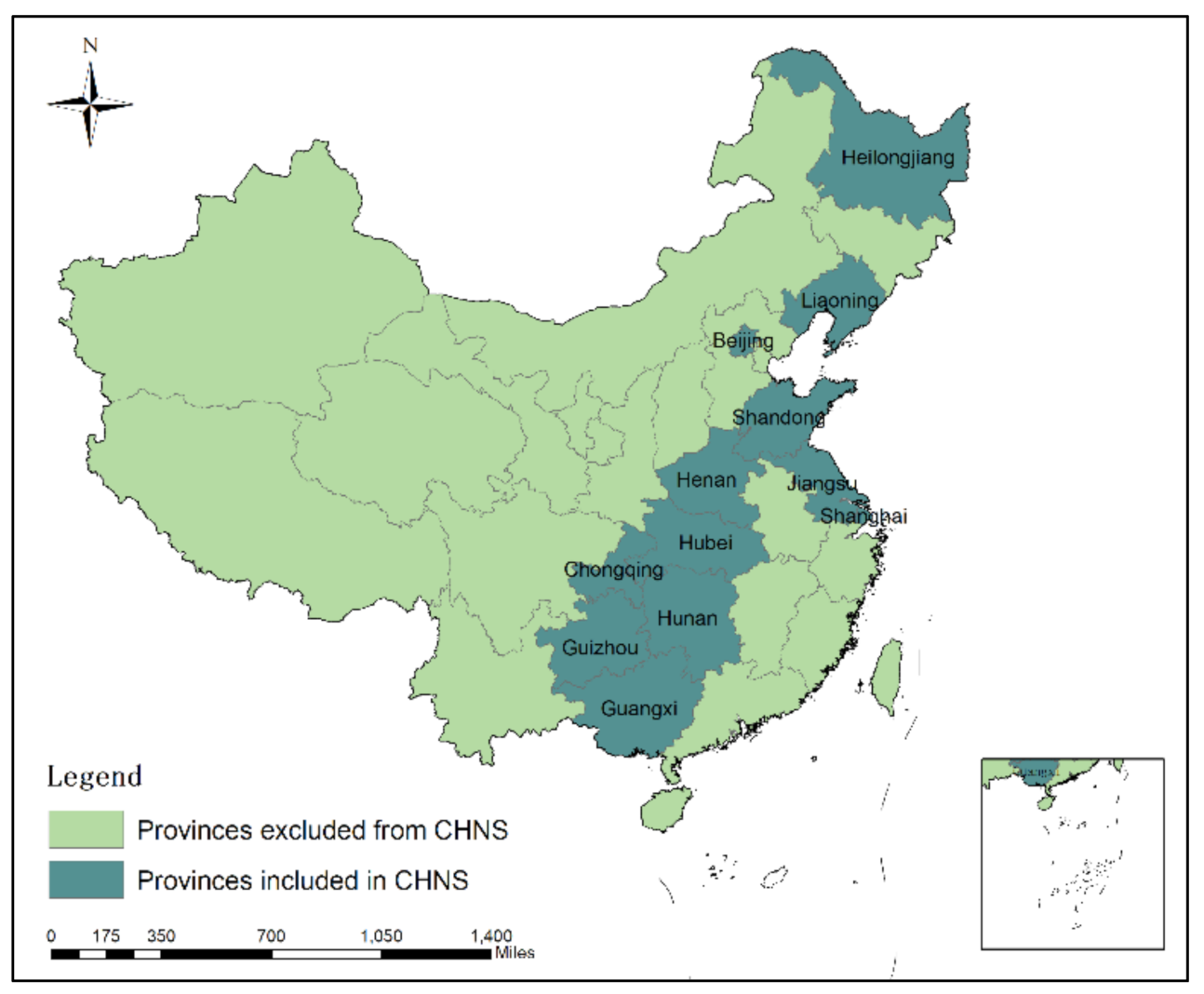
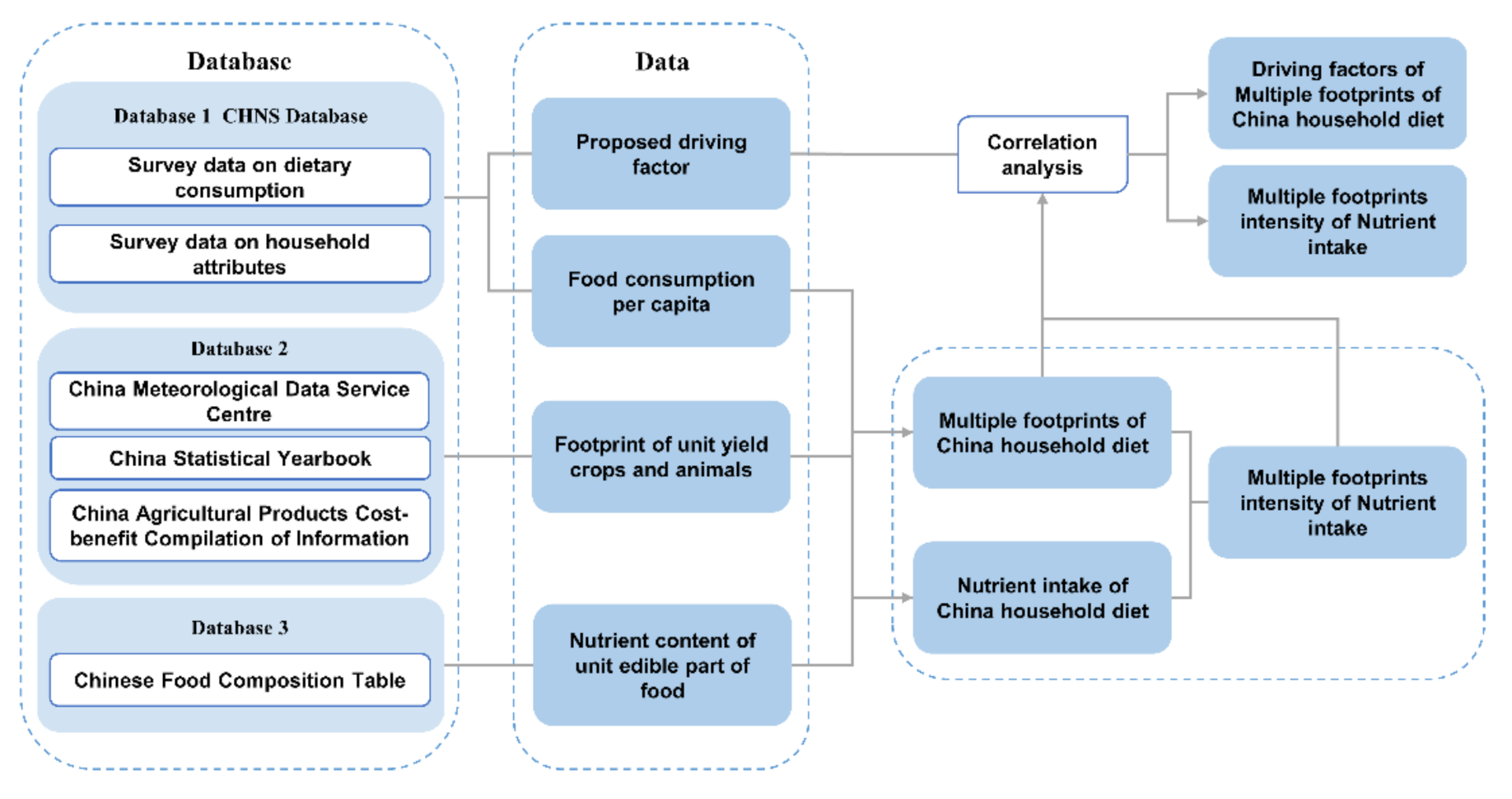
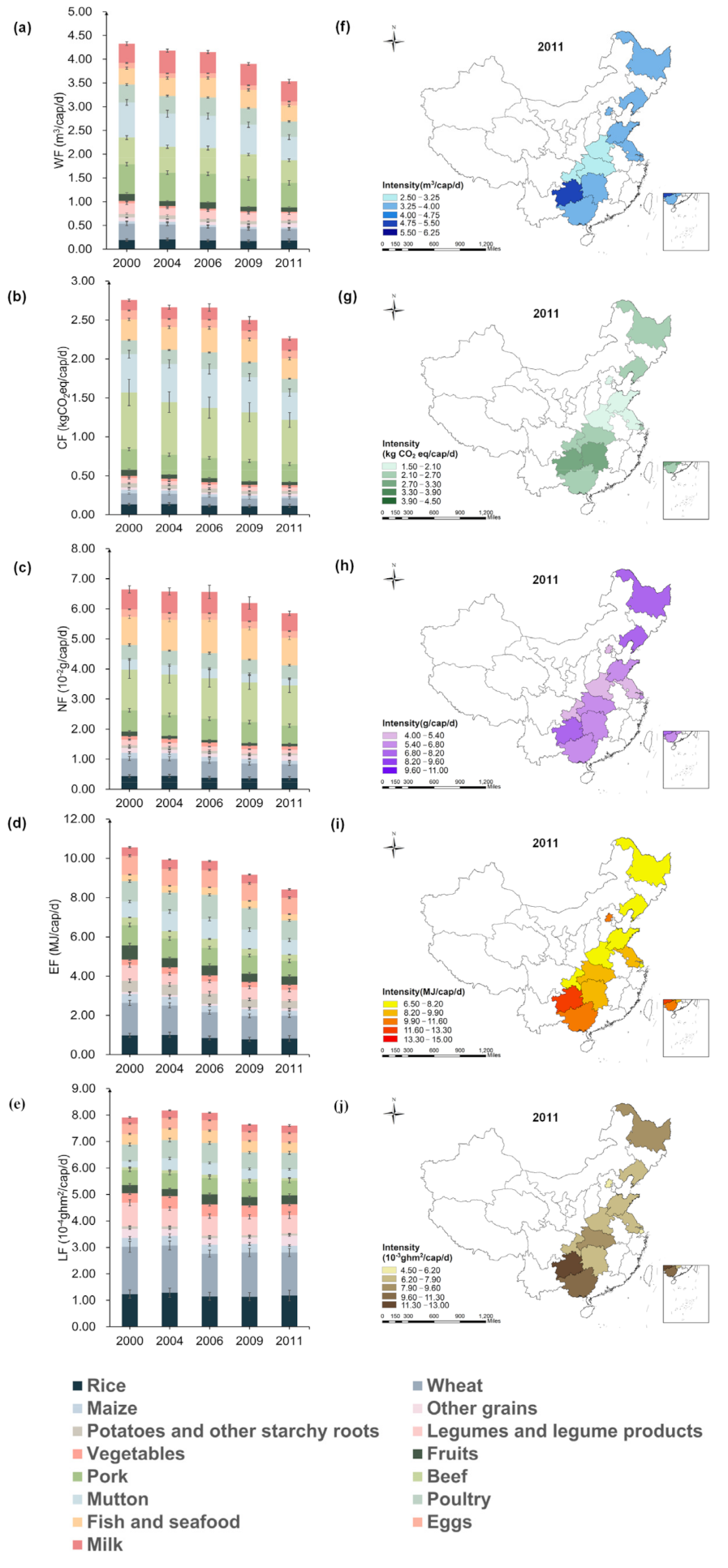
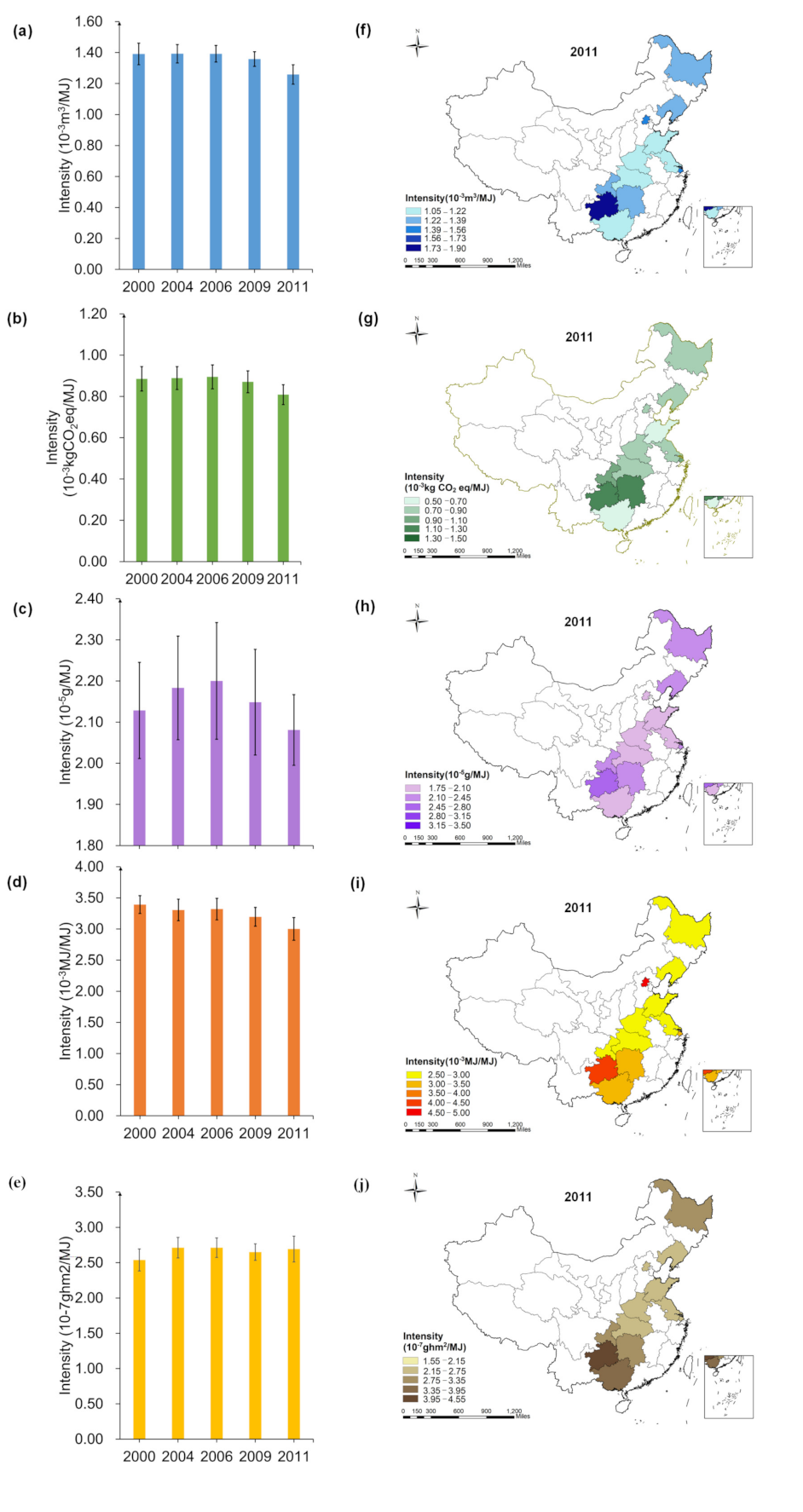
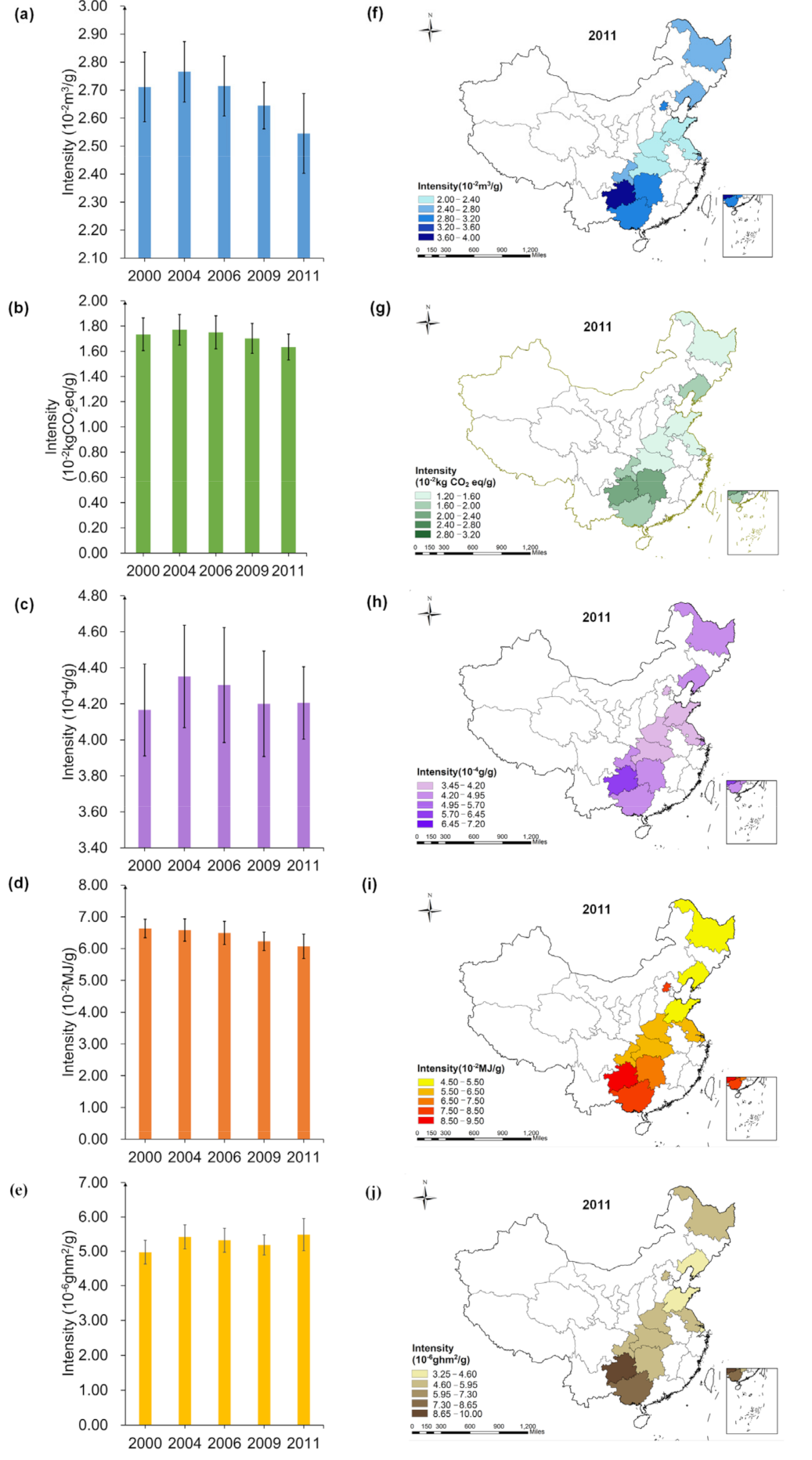
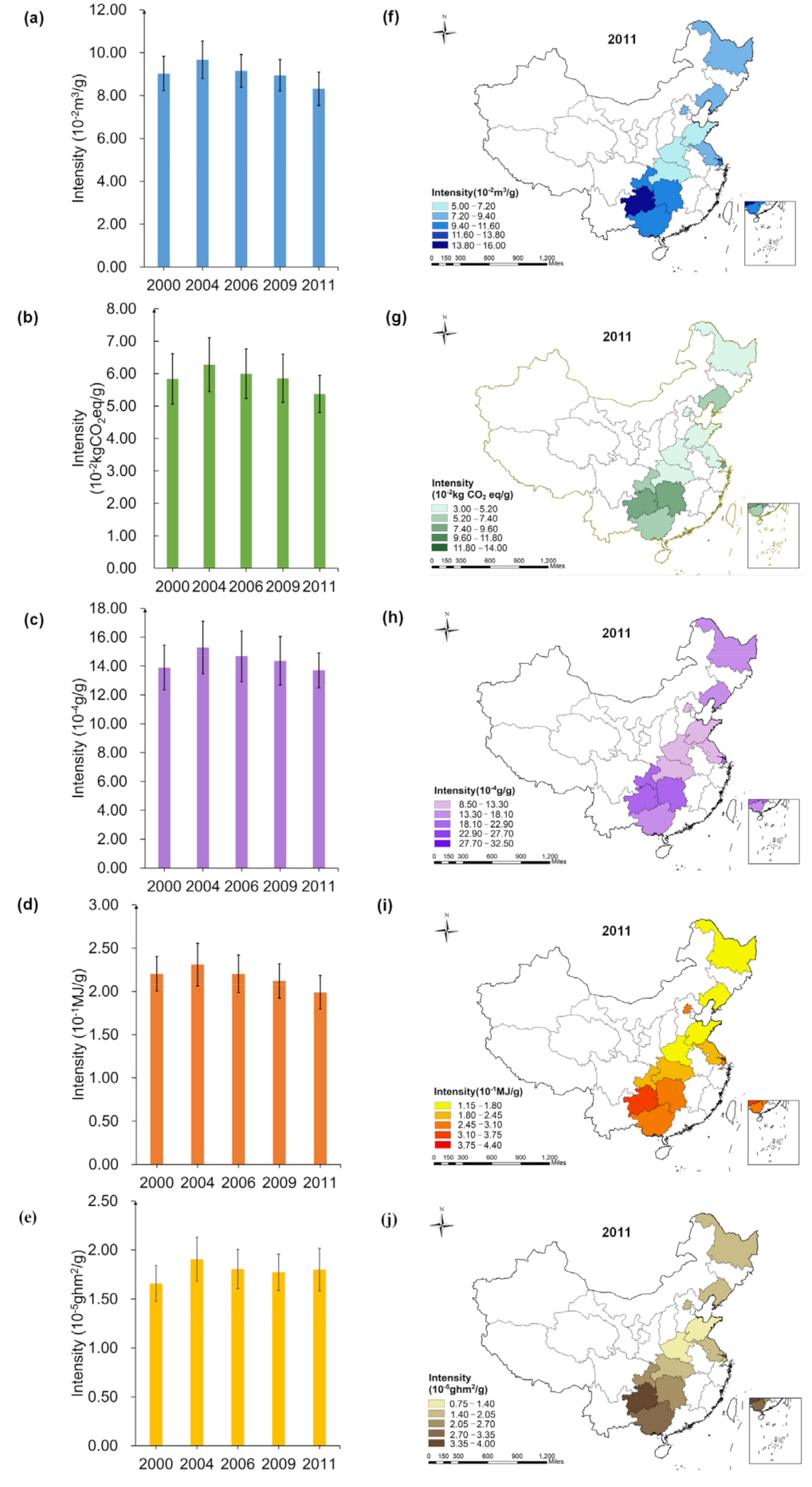

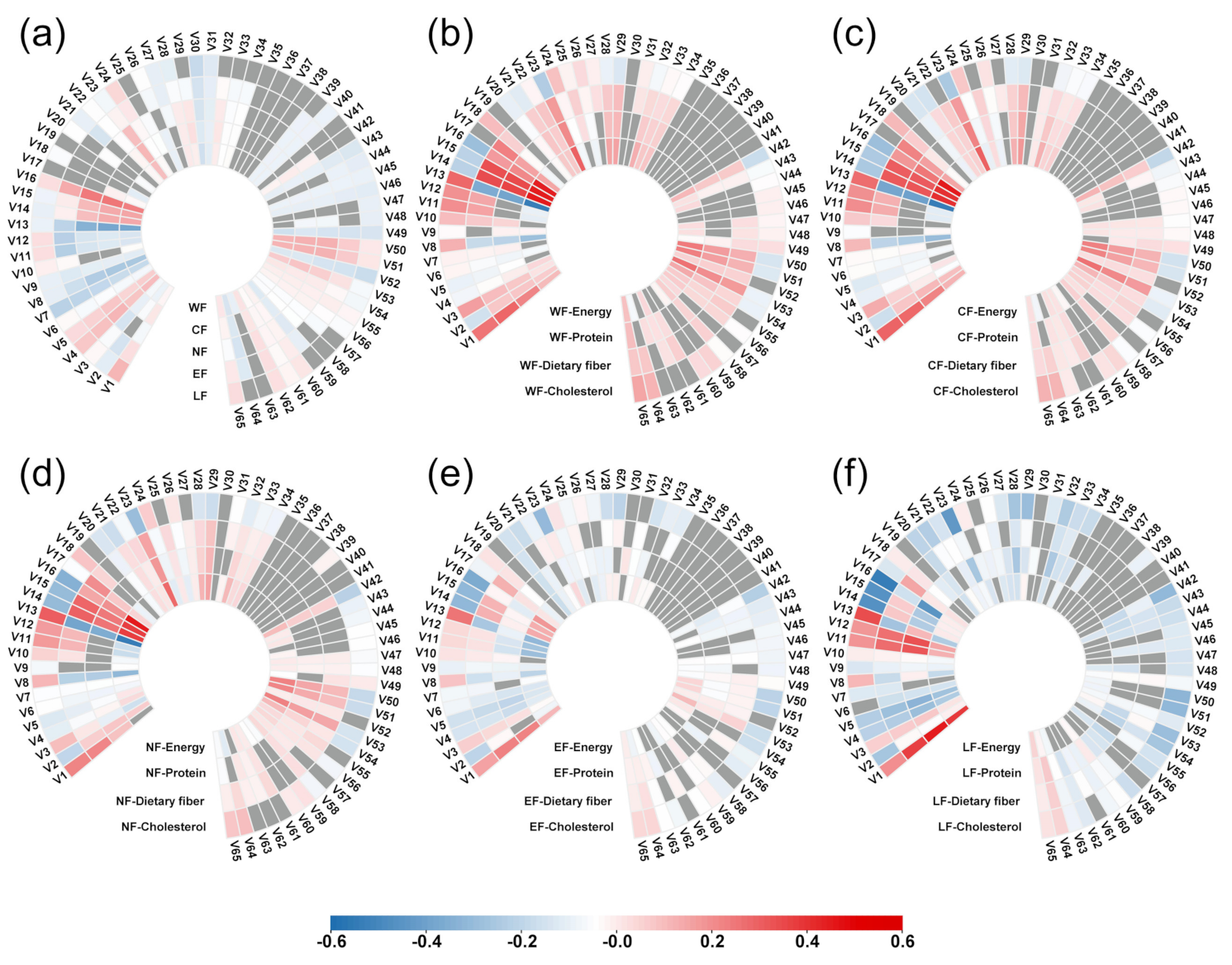
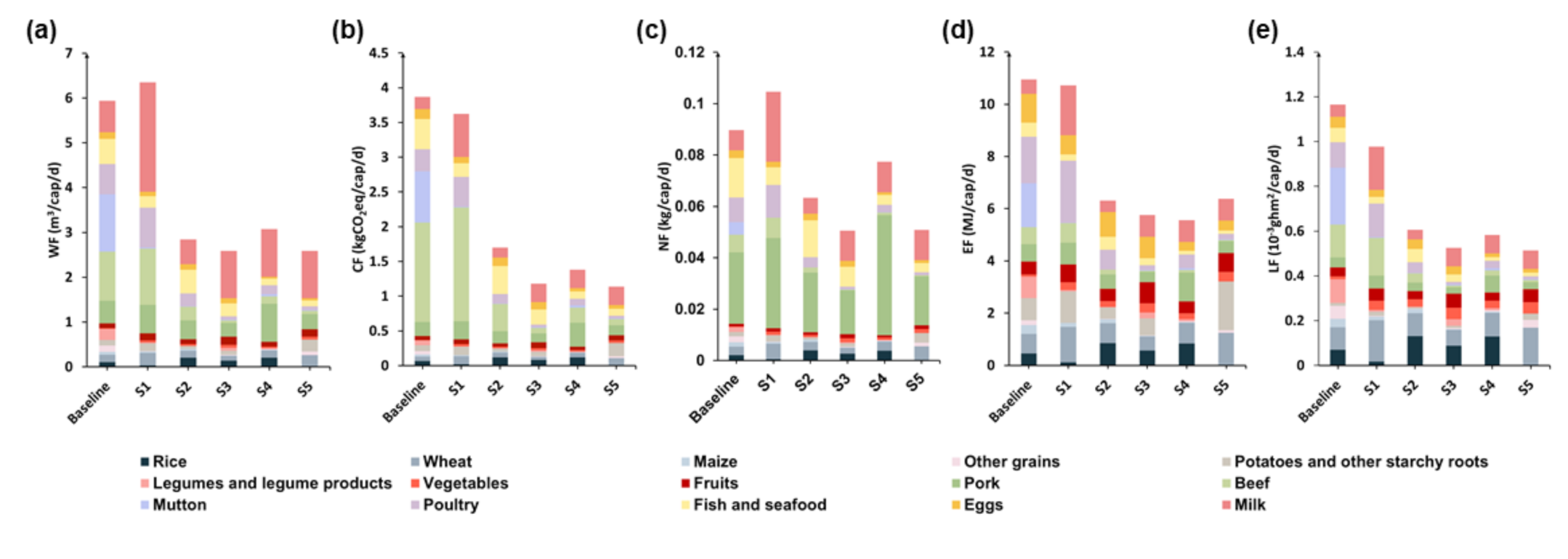

| Primary Classification | Secondary Classification | Food Type |
|---|---|---|
| Cereals and starchy roots | Wheat | Plant-based foods |
| Maize | Plant-based foods | |
| Rice | Plant-based foods | |
| Other grains | Plant-based foods | |
| Potatoes and other starchy roots | Plant-based foods | |
| Legumes and legume products | Legumes and legume products | Plant-based foods |
| Vegetables and fruits | Vegetables | Plant-based foods |
| Fruits | Plant-based foods | |
| Animal-derived foods | Beef | Animal-derived foods |
| Pork | Animal-derived foods | |
| Poultry | Animal-derived foods | |
| Mutton | Animal-derived foods | |
| Fish and seafood | Animal-derived foods | |
| Eggs | Animal-derived foods | |
| Milk | Animal-derived foods |
| Type | Sample Size | Variable | Code |
|---|---|---|---|
| Household attributes | 63,550 | Province | V1 |
| 63,550 | Survey year | V2 | |
| 63,550 | Nationality | V3 | |
| 59,074 | Height (cm) | V4 | |
| 58,895 | Weight (kg) | V5 | |
| 63,550 | Calculated age in years to 0 decimal points | V6 | |
| 63,550 | Gender | V7 | |
| 63,032 | Urban site or rural site | V8 | |
| 54,564 | Marital status | V9 | |
| 3436 | Is R a national minority | V10 | |
| 3413 | R’s birthplace | V11 | |
| 3403 | R’s “old home”(father’s birthplace) | V12 | |
| Nutritional intake ratio | 63,414 | 3-day average: carbohydrate (g) | V13 |
| 63,414 | 3-day average: fat (g) | V14 | |
| 63,414 | 3-day average: energy (kcal) | V15 | |
| 63,414 | 3-day average: protein (g) | V16 | |
| Income status | 14,288 | Work in HH garden/orchard last year | V17 |
| 12,311 | Number Of months farmed last year | V18 | |
| 12,647 | Type of farming business | V19 | |
| 13,000 | Individual farming income (Yuan) | V20 | |
| 15,071 | Individual gardening income (Yuan) | V21 | |
| 8420 | Individual livestock income (Yuan) | V22 | |
| 39,993 | Total net individual income (Yuan) | V23 | |
| 53,168 | Presently working? | V24 | |
| 32,017 | Primary occupation | V25 | |
| 32,084 | Has a secondary occupation | V26 | |
| 26,115 | Average of days/week worked last year (Day) | V27 | |
| 25,928 | Average of hours/day worked last year (h) | V28 | |
| 12,709 | Average monthly wage last year (Yuan) | V29 | |
| Health and medical conditions | 1242 | B-feeding: ever breastfed child? | V30 |
| 49,407 | Been sick or injured in last 4 weeks? | V31 | |
| 20,269 | Monthly contribution to medical insurance (Yuan) | V32 | |
| 40,943 | Priorities: physically active | V33 | |
| 40,938 | Priorities: healthy diet | V34 | |
| 58,834 | Blindness in 1 eye? | V35 | |
| 58,834 | Blindness in both eyes? | V36 | |
| 58,833 | Loss of 1 arm or the use of 1 arm? | V37 | |
| 58,834 | Loss of both arms or use of both arms? | V38 | |
| 58,829 | Loss of 1 leg or the use of 1 leg? | V39 | |
| 58,813 | Loss of both legs or use of both legs? | V40 | |
| 14,050 | Currently pregnant? | V41 | |
| 62,609 | Do you have medical insurance? | V42 | |
| 54,719 | Diagnosed with high blood pressure? | V43 | |
| 54,422 | Diagnosed with diabetes? | V44 | |
| 52,037 | Diagnosed with myocardial infarction? | V45 | |
| 51,879 | Diagnosed with apoplexy? | V46 | |
| 12,828 | Doctor’s diagnosis of illeness/injury: tumor | V47 | |
| 54,818 | History of bone fracture? | V48 | |
| 30,775 | Comparative health status | V49 | |
| Educational level and social life | 55,024 | Years of education in regular school | V50 |
| 59,880 | Highest level of education attained | V51 | |
| 58,951 | Currently in school? | V52 | |
| 45,874 | Ever go to internet cafe | V53 | |
| 44,385 | Know about Chinese dietary guidelines | V54 | |
| Living habits | 7188 | School: Do physical exercises? | V55 |
| 7769 | Body shapes: looks most like you | V56 | |
| 6736 | Weight: under/normal/over | V57 | |
| 7891 | On a diet last year? | V58 | |
| 7388 | Physical activity: too little/right/too much | V59 | |
| 54,913 | Ever smoked cigarettes? | V60 | |
| 14,083 | Number of cigarettes smokes per day | V61 | |
| 54,757 | Drank beer/alcohol last year? | V62 | |
| 16,935 | Frequency of alcohol consumption | V63 | |
| 25,928 | Memory test: rate present life | V64 | |
| 11,116 | Like to eat hot pepper or spicy food? | V65 |
Publisher’s Note: MDPI stays neutral with regard to jurisdictional claims in published maps and institutional affiliations. |
© 2021 by the authors. Licensee MDPI, Basel, Switzerland. This article is an open access article distributed under the terms and conditions of the Creative Commons Attribution (CC BY) license (https://creativecommons.org/licenses/by/4.0/).
Share and Cite
Long, Y.; Hu, R.; Yin, T.; Wang, P.; Liu, J.; Muhammad, T.; Chen, X.; Li, Y. Spatial-Temporal Footprints Assessment and Driving Mechanism of China Household Diet Based on CHNS. Foods 2021, 10, 1858. https://doi.org/10.3390/foods10081858
Long Y, Hu R, Yin T, Wang P, Liu J, Muhammad T, Chen X, Li Y. Spatial-Temporal Footprints Assessment and Driving Mechanism of China Household Diet Based on CHNS. Foods. 2021; 10(8):1858. https://doi.org/10.3390/foods10081858
Chicago/Turabian StyleLong, Yanling, Runzhi Hu, Tuo Yin, Pengxiang Wang, Jiamin Liu, Tahir Muhammad, Xiuzhi Chen, and Yunkai Li. 2021. "Spatial-Temporal Footprints Assessment and Driving Mechanism of China Household Diet Based on CHNS" Foods 10, no. 8: 1858. https://doi.org/10.3390/foods10081858
APA StyleLong, Y., Hu, R., Yin, T., Wang, P., Liu, J., Muhammad, T., Chen, X., & Li, Y. (2021). Spatial-Temporal Footprints Assessment and Driving Mechanism of China Household Diet Based on CHNS. Foods, 10(8), 1858. https://doi.org/10.3390/foods10081858






